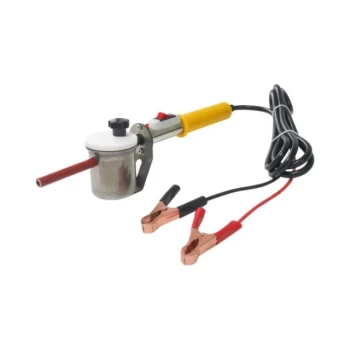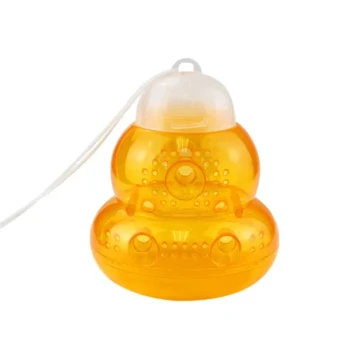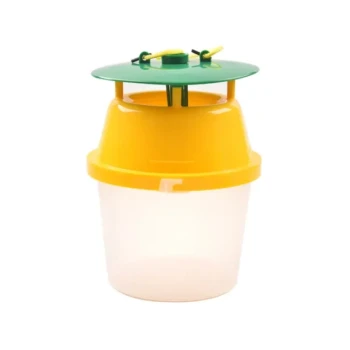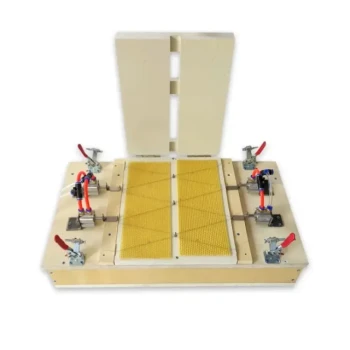In professional beekeeping, oxalic acid is a registered varroa mite treatment with three distinct, legally approved application methods. These are the solution spray for packaged bees, the solution trickle or "dribble" for established hives, and the vapor or "sublimation" method for established hives. Each method is designed for a specific context and carries its own set of operational considerations.
The core decision for most beekeepers is not if they should use oxalic acid, but how. Choosing between the dribble and vaporization methods requires a clear understanding of the trade-offs between cost, bee safety, beekeeper safety, and equipment.
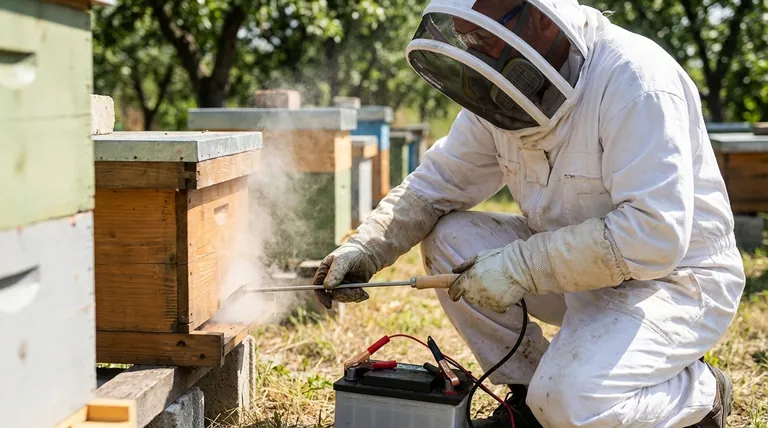
Understanding the Goal: Varroa Mite Control
What is Oxalic Acid's Role?
Oxalic acid is a naturally occurring organic compound found in many plants, including honey. It is used in beekeeping as a "miticide" to control the parasitic Varroa destructor mite.
How it Works
When applied correctly, oxalic acid is highly effective at killing varroa mites that are on the adult bees (known as phoretic mites). It is not effective against mites reproducing under the capped brood, which is a critical factor in treatment timing.
The Three Registered Application Methods
Method 1: The Solution Spray (For Packaged Bees)
This method is specifically for treating new packages of bees before they are installed in a hive. A light sugar solution containing a precise concentration of oxalic acid is sprayed directly onto the bees in their transport cage.
Because packaged bees are almost always broodless, this single application can be extremely effective at starting a new colony with a very low mite count.
Method 2: The Dribble Method (Solution in Hive)
The dribble method involves mixing oxalic acid dihydrate with a 1:1 sugar-water solution. This solution is then trickled or "dribbled" directly onto the bees in the spaces between the frames.
A large syringe is typically used to apply a measured amount (usually 5ml per occupied bee space) to ensure an accurate dose. This is a direct contact method that relies on the bees' grooming habits to spread the solution throughout the cluster.
Method 3: The Vaporization Method (Sublimation)
This method uses a specialized tool called a vaporizer to heat oxalic acid dihydrate crystals. The heat causes the crystals to sublimate, turning directly from a solid into a gas.
This fine vapor fills the hive cavity and then re-crystallizes, coating all the surfaces—and the bees—with microscopic crystals. This is also a contact method that kills mites on the adult bees.
Understanding the Trade-offs: Dribble vs. Vaporization
Efficacy and Timing
Both the dribble and vaporization methods are highly effective, often achieving over 90% efficacy when a colony is broodless. This makes them ideal for late fall or winter treatments when the queen has stopped laying.
If a significant amount of brood is present, the efficacy of a single treatment drops dramatically, as most mites are protected under the cappings.
Impact on Bee Health
The dribble method can be considered "harder" on the bees. The acidic sugar solution is ingested, which can be stressful, and it is generally not recommended to perform multiple dribble treatments in a season.
Vaporization is widely considered to be gentler on the bees. Since the bees are not ingesting a solution, repeated treatments (if necessary as part of an integrated pest management plan) are better tolerated.
Beekeeper Safety
The dribble method is relatively safe, requiring only gloves and eye protection to prevent skin and eye contact with the acidic solution.
Vaporization poses a significant respiratory hazard to the beekeeper. The oxalic acid vapor is a severe irritant to the lungs and mucous membranes. An appropriately rated respirator, along with goggles and gloves, is non-negotiable safety equipment for this method.
Equipment and Cost
The dribble method is extremely inexpensive. The only required equipment beyond the oxalic acid and sugar is a mixing jar and a syringe, costing only a few dollars.
Vaporization requires an initial investment in a vaporizer, which can range from $30 for a simple wand-style unit to several hundred dollars for a high-volume, professional model.
Making the Right Choice for Your Apiary
Choosing an application method depends entirely on your specific situation, priorities, and scale of operation.
- If your primary focus is low cost and simplicity for a few hives: The dribble method is an effective and accessible starting point, provided you use it during a broodless period.
- If your primary focus is treating multiple hives quickly and with minimal stress on the bees: The vaporization method is the superior choice, as long as you invest in and properly use the required safety equipment.
- If you are installing a new package of bees: The spray method is the designated and most effective approach for ensuring a clean start for your colony.
Ultimately, using oxalic acid correctly is a cornerstone of responsible and sustainable beekeeping.
Summary Table:
| Method | Best For | Key Consideration |
|---|---|---|
| Spray | New packaged bees | Highly effective for broodless bees |
| Dribble | Low-cost, small-scale operations | Can be stressful for bees; timing is critical |
| Vaporization | Larger apiaries, bee health focus | Requires safety equipment (respirator) and initial investment |
Ready to implement the most effective varroa mite control strategy for your apiary?
At HONESTBEE, we supply commercial apiaries and beekeeping equipment distributors with the professional-grade tools needed for safe and efficient oxalic acid application. Whether you're scaling up your vaporization program or need reliable supplies for the dribble method, our wholesale-focused operations ensure you get the right equipment at competitive prices.
Contact our expert team today to discuss your mite management needs and optimize your hive health.
Visual Guide
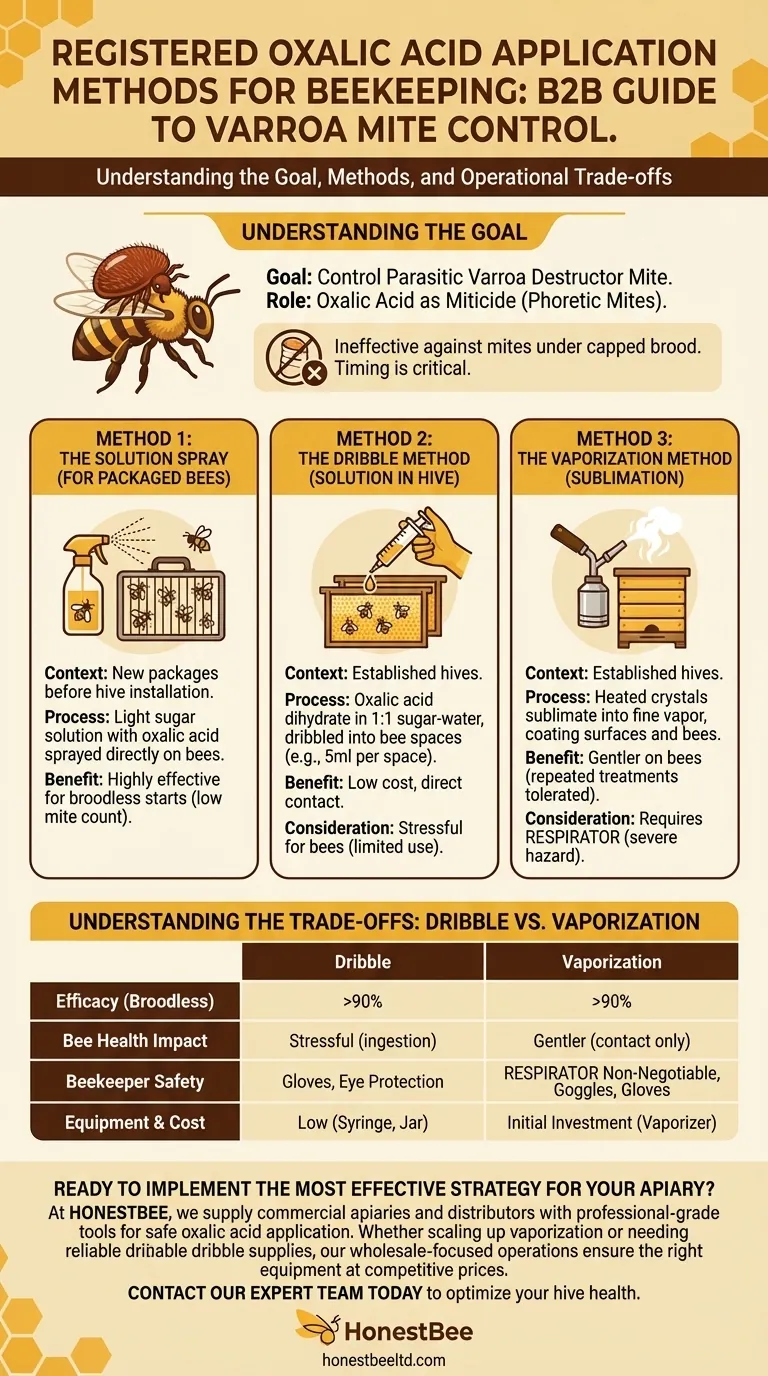
Related Products
- Oxalic Acid Vaporizer 12V for Bee Varroa Mite Treatment
- 12V Bee Mite Removal Evaporator Oxalic Acid Vaporizer for Bee Fumigation Treatment 180W Atomization
- Adjustable Formic and Acetic Acid Dispenser for Bee Mite Treatment
- Wooden Bee Brush with Triple Row Artificial Fiber for Beekeeping
- Professional Bamboo Queen Isolation Cage
People Also Ask
- How is the oxalic acid solution prepared for vaporization? No Solution Needed—Use Dry Crystals for Varroa Control
- What is the most common method of applying oxalic acid for mite control? Dribble vs. Vaporization for Varroa
- What safety precautions should be taken during Oxalic Acid Vaporization? Essential PPE & Procedures
- What should be done after applying the vapor? A Step-by-Step Guide to Sealing Your Hive
- What are the methods for applying oxalic acid in beekeeping? Control Varroa Mites Effectively

